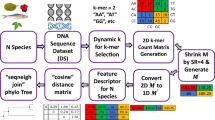Abstract
A comparison of amino acid sequences is performed for orthologs to the meiosis-specific proteins in humans and seven other species, including animals, fungi, and plants that serve as models for the study of molecular mechanisms of meiosis. It is demonstrated that the RAD51 recombination mediator protein is the most conserved of the studied proteins. Its meiotic homolog DMC1 is less conserved, like the MHL1 mismatch-repair protein. The meiosis-specific SPO11 endonuclease is the least conserved among the studied meiotic enzymes. Structural proteins of meiotic chromosomes are poorly conserved. REC8 meiotic cohesin has 6 times lower similarity in the organisms from different kingdoms than its somatic homolog RAD21. The intermediate conservation level is characteristic of the synaptonemal complex proteins containing HORMA domain. Two functional domains of SPO11 endonuclease and MutL Trans_MLH1 domain of MLH1 enzyme are equally or even less conserved than the whole proteins. HORMA functional domain of a number of synaptonemal complex proteins is only 2–3 times more conserved than the whole molecule. Thus, among the key meiotic proteins, the most conserved are proteins responsible for the accuracy of meiotic recombination. Cohesins, synaptonemal complex proteins, and meiosis-specific SPO11 endonuclease are less conserved even within their functional domains. Obviously, the meiosis-specific proteins have undergone independent evolution in different phylogenetic lineages of eukaryotes.
Similar content being viewed by others
References
Priming, M., Williams, R.M., Winzeler, E.A., et al., The core meiotic transcriptome of budding yeast, Nat. Genet., 2000, vol. 26, pp. 415–423. doi 10.1038/82539
Waldman, B.-A.H., Shahar, I., Yitzchak, A., et al., Expression and chromosomal organization of mouse meiotic genes, Mol. Reprod. Dev., 2010, vol. 77, pp. 241–248. doi 10.1002/mrd.21139
Revenkova, E. and Jessberger, R, Keeping sister chromatids together: cohesins in meiosis, Reproduction, 2005, vol. 130, pp. 783–790. doi 10.1530/rep.1.00864
Kitajima, T.S., Kawashima, S.A., and Watanabe, Y, The conserved kinetochore protein shugoshin protects centromeric cohesion during meiosis, Nature, 2004, vol. 427, pp. 510–517. doi 10.1038/nature02312
Heyting, C, Synaptonemal complex: structure and function, Curr. Opin. Cell Biol., 1996, vol. 8, pp. 389–396. doi 10.1016/S0955-0674(96)80015-9
Penkina, M.V., Karpova, O.I., and Bogdanov, Yu.F., Synaptonemal complex proteins: specific proteins of meiotic chromosomes, Mol. Biol. (Moscow), 2002, vol. 36, no. 3, pp. 304–313. doi 10.1023/A:1016086624640
Marcon, E. and Moens, P.B, The evolution of meiosis: recruitment and modification of somatic DNA-repair proteins, BioEssays, 2005, vol. 27, pp. 795–808. doi 10.1002/bies.20264
Hunter, N. and Kleckner, N, The single-end invasion: an asymmetric intermediate at the double-strand break to double-holliday junction transition of meiotic recombination, Cell, 2001, vol. 106, pp. 59–70. doi 10.1016/S0092-8674(01)00430-5
Smith, A.V. and Roeder, G.S, Cloning and characterization of the Kluyveromyces lactis homologs of the Saccharomyces cerevisiae RED1 and HOP1 genes, Chromosoma, 2000, vol. 109, pp. 50–61.
Bogdanov, Yu.F., Dadashev, S.Ya., and Grishaeva, T.M, Comparative genomics and proteomics of Drosophila, Brenner’s nematode, and Arabidopsis: identification of functionally similar genes and proteins of meiotic chromosome synapsis, Russ. J. Genet., 2002, vol. 38, no. 8, pp. 908–917.
Page, S.L. and Hawley, R.S, The genetics and molecular biology of the synaptonemal complex, Annu. Rev. Cell Dev. Biol., 2004, vol. 20, pp. 525–558. doi 10.1146/annurev.cellbio.19.111301.155141
Zickler, D. and Kleckner, N, Meiotic chromosomes: integrating structure and function, Annu. Rev. Genet., 1999, vol. 33, pp. 603–704. doi 10.1146/annurev. genet.33.1.603
Zickler, D. and Kleckner, N, Recombination, pairing, and synapsis of homologous chromosomes, Cold Spring Harbor Perspect. Biol., 2015, vol. 7, pp. 1–25. doi 10.1101/cshpersppect.a016626
Pasierbek, P., Jantsch, M., Melcher, M., et al., A Caenorhabditis elegans cohesion protein with functions in meiotic chromosome pairing and disjunction, Genes Dev., 2001, vol. 15, pp. 1349–1360. doi 10.1101/gad. 192701
Grishaeva, T.M., Dadashev, S.Ya., and Bogdanov, Yu.F., Meiotic Rec8 cohesins and their mitotic Rad21 orthologs: comparison in silico, Mol. Biol. (Moscow), 2007, vol. 41, no. 4, pp. 674–676. doi 10.1134/S0026893307040231
Stassen, N.Y., Logsdon, J.M., Vora, G.J., et al., Isolation and characterization of rad51 orthologs from Coprinus cinereus and Lycopersicon esculentum, and phylogenetic analysis of eukaryotic recA homologs, Curr. Genet., 1997, vol. 31, pp. 144–157.
Bogdanov, Yu.F., Grishaeva, T.M., and Dadashev, S.Ya., Similarity of the domain structure of proteins as a basis for the conservation of meiosis, Int. Rev. Cytol., 2007, vol. 257, pp. 84–142. doi 10.1016/S0074- 7696(07)57003-8
Kumar, R., Bourbon, H-M., and de Massy, B, Functional conservation of Mei4 for meiotic DNA double-strand break formation from yeasts to mice, Genes Dev., 2010, vol. 24, pp. 1266–1280. doi 10.1101/gad.571710
Heidmann, D., Horn, S., Heidmann, S., et al., The Drosophila meiotic kleisin C(2)M functions before the meiotic divisions, Chromosoma, 2004, vol. 113, pp. 177–187. doi 10.1007/s00412-004-0305-5
Muniyappa, K., Kshirsagar, R., and Ghodke, I, The HORMA domain: an evolutionarily conserved domain discovered in chromatin-associated proteins, has unanticipated diverse functions, Gene, 2014, vol. 545, pp. 194–197. doi 10.1016/j.gene.2014.05.020
Grishaeva, T.M. and Bogdanov, Yu.F., Conservation and variability of synaptonemal complex proteins in phylogenesis of eukaryotes, Int. J. Evol. Biol., 2014, vol. 2014, article ID 856230. doi 10.1155/2014/856230
Keeney, S., Spo11 and the formation of DNA doublestrand breaks in meiosis, Genome Dyn. Stab., 2008, vol. 2, pp. 81–123. doi 10.1007/7050_2007_026
Shinohara, A. and Shinohara, M, Roles of RecA homologues Rad51 and Dmc1 during meiotic recombination, Cytogen. Genome Res., 2004, vol. 107, pp. 201–207. doi 10.1159/000080598
Bogdanov, Yu.F., Evolution of meiosis in unicellular and multicellular eukaryotes: aromorphosis at the cellular level, Zh. Obshch. Biol., 2008, vol. 69, no. 2, pp. 102–117.
Author information
Authors and Affiliations
Corresponding author
Additional information
Original Russian Text © T.M. Grishaeva, Yu.F. Bogdanov, 2017, published in Genetika, 2017, Vol. 53, No. 5, pp. 541–550.
Rights and permissions
About this article
Cite this article
Grishaeva, T.M., Bogdanov, Y.F. Evolutionary conservation of recombination proteins and variability of meiosis-specific proteins of chromosomes. Russ J Genet 53, 542–550 (2017). https://doi.org/10.1134/S1022795417040081
Received:
Accepted:
Published:
Issue Date:
DOI: https://doi.org/10.1134/S1022795417040081




